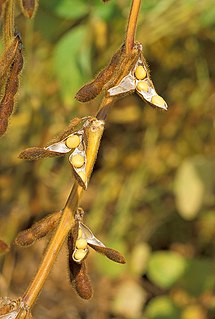
An agar plate is a Petri dish that contains agar as a solid growth medium plus nutrients, used to culture microorganisms. Sometimes selective compounds are added to influence growth, such as antibiotics.

Eosin methylene blue is a selective stain for gram-negative bacteria. EMB contains dyes that are toxic to gram-positive bacteria. EMB is the selective and differential medium for coliforms. It is a blend of two stains, eosin and methylene blue in the ratio of 6:1. A common application of this stain is in the preparation of EMB agar, a differential microbiological medium, which slightly inhibits the growth of Gram-positive bacteria and provides a color indicator distinguishing between organisms that ferment lactose and those that do not. Organisms that ferment lactose display "nucleated colonies"—colonies with dark centers.
Lauryl tryptose broth (LSB) is a selective growth medium (broth) for coliforms.

MacConkey agar is an indicator, a selective and differential culture medium for bacteria designed to selectively isolate Gram-negative and enteric bacilli and differentiate them based on lactose fermentation. The crystal violet and bile salts inhibit the growth of Gram-positive organisms which allows for the selection and isolation of gram-negative bacteria. Enteric bacteria that have the ability to ferment lactose can be detected using the carbohydrate lactose, and the pH indicator neutral red.

Lysogeny broth (LB) is a nutritionally rich medium primarily used for the growth of bacteria. Its creator, Giuseppe Bertani, intended LB to stand for lysogeny broth, but LB has also come to be commonly referred to as Luria broth, Lennox broth, or Luria-Bertani medium. The formula of the LB medium was published in 1951 in the first paper of Bertani on lysogeny. In this article he described the modified single-burst experiment and the isolation of the phages P1, P2, and P3. He had developed the LB medium to optimize Shigella growth and plaque formation.
Sorbitol MacConkey agar is a variant of traditional MacConkey agar used in the detection of E. coli O157:H7. Traditionally, MacConkey agar has been used to distinguish those bacteria that ferment lactose from those that do not. This is important because gut bacteria, such as Escherichia coli, can typically ferment lactose, while important gut pathogens, such as Salmonella enterica and most shigellas are unable to ferment lactose. Shigella sonnei can ferment lactose, but only after prolonged incubation, so it is referred to as a late-lactose fermenter.
The indole test is a biochemical test performed on bacterial species to determine the ability of the organism to convert tryptophan into indole. This division is performed by a chain of a number of different intracellular enzymes, a system generally referred to as "tryptophanase."
Trypticase soy agar or tryptone soya agar (TSA) and Trypticasesoy broth or tryptone soya broth (TSB) with agar are growth media for the culturing of bacteria. They are general-purpose, nonselective media providing enough nutrients to allow for a wide variety of microorganisms to grow. They are used for a wide range of applications, including culture storage, enumeration of cells (counting), isolation of pure cultures, or simply general culture.
Super Optimal Broth is a nutrient-rich bacterial growth medium used for microbiological culture, generally of Escherichia coli. It was developed by Douglas Hanahan in 1983 and is an adjusted version of the commonly used LB media. Growth of E. coli in SOB or SOC medium results in higher transformation efficiencies of plasmids.

Hektoen enteric agar is a selective and differential agar primarily used to recover Salmonella and Shigella from patient specimens. HEA contains indicators of lactose fermentation and hydrogen sulfide production; as well as inhibitors to prevent the growth of Gram-positive bacteria. It is named after the Hektoen Institute in Chicago, where researchers developed the agar.
Enrichment culture is the use of certain growth media to favor the growth of a particular microorganism over others, enriching a sample for the microorganism of interest. This is generally done by introducing nutrients or environmental conditions that only allow the growth of an organism of interest. Enrichment cultures are used to increase a small number of desired organisms to detectable levels. This allows for the detection and identification of microorganisms with a variety of nutritional needs. Enrichment cultures are often used for soil and fecal samples.

Endo agar is a microbiological growth medium with a faint pink colour. Originally developed for the isolation of Salmonella typhi, it is now used mostly as a coliform medium. Most gram-negative organisms grow well in this medium, while growth of gram-positive organisms is inhibited. Coliform organisms ferment the lactose in this medium, producing a green metallic sheen, whereas non-lactose-fermenting organisms produce clear, colourless colonies, i.e. Salmonella sp..
Middlebrook 7H9 broth is a liquid growth medium specially used for culture of Mycobacterium species, notably Mycobacterium tuberculosis.
Middlebrook 7H10 Agar is a solid growth medium specially used for culture of Mycobacterium, notably Mycobacterium tuberculosis. It has been reported that the 7H10 medium tends to grow fewer contaminants than the egg-based media commonly used for the cultivation of mycobacteria.
Glucose phosphate broth is used to perform Methyl Red (MR) test and Voges Proskauer (VP) test.

The N.Y.C medium or GC medium agar is used for isolating Gonococci.

Granada medium is a selective and differential culture medium designed to selectively isolate Streptococcus agalactiae and differentiate it from other microorganisms. Granada Medium was developed by Dr. Manuel Rosa-Fraile et al. at the Service of Microbiology in the Hospital Virgen de las Nieves in Granada (Spain).
Peptone water is a microbial growth medium composed of peptic digest of animal tissue and sodium chloride. The pH of the medium is 7.2±0.2 at 25 °C and is rich in tryptophan. Peptone water is also a non-selective broth medium which can be used as a primary enrichment medium for the growth of bacteria.












